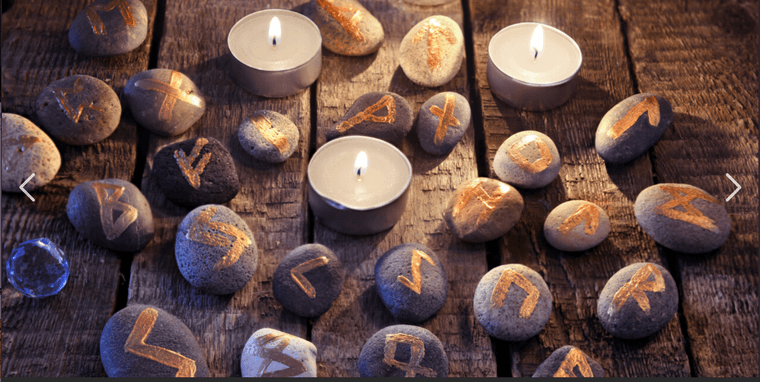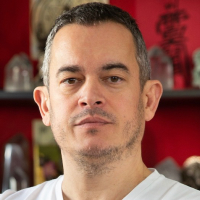Les Runes et leurs Usages
-

La magie du vieux Futhark (ou Futhark ancien) est un sujet fascinant qui mêle mythologie nordique, symbolisme ésotérique et pratiques mystiques issues des traditions germaniques et scandinaves. Le vieux Futhark est l’alphabet runique le plus ancien, utilisé par les peuples germaniques entre le IIᵉ et le VIIIᵉ siècle de notre ère. Il est composé de 24 runes, chacune dotée d’une signification à la fois phonétique, symbolique et magique.
L'étymologie du mot "Futhark" provient des six premières runes de cet alphabet. Ce système d'écriture a d’abord servi à des fins pragmatiques (inscriptions funéraires, marques de propriété, formules mémorielles), mais il a également acquis une importance rituelle et magique au fil du temps.
Dans la mythologie nordique, l’origine des runes est attribuée au dieu Odin. Selon l’Edda poétique (Hávamál, strophes 138-139), Odin se serait suspendu pendant neuf jours et neuf nuits à l’arbre-monde Yggdrasil, transpercé par sa propre lance, afin d’accéder à la sagesse runique. En récompense de son sacrifice, il obtint la connaissance des runes et les transmit aux hommes.
La magie du vieux Futhark repose sur l'idée que chaque rune est dotée d’une énergie spécifique, capable d’influencer la réalité lorsqu’elle est utilisée avec justesse. Parmi les différentes expressions de cette magie, l’une des plus emblématiques est le Galdr, une pratique basée sur des incantations vocales où les sons runiques, porteurs de vibrations puissantes, modifient l’environnement spirituel et physique. Selon la rune invoquée, ces chants pouvaient favoriser la prospérité, comme avec Fehu, ou encore renforcer la communication divine, à l’image d’Ansuz.
Le Seiðr, une autre forme de magie intimement liée aux traditions chamaniques et prophétiques, illustre également le rôle fondamental des runes dans les pratiques ésotériques nordiques. Associée à la transe et à la divination, cette technique était particulièrement prisée par les adeptes souhaitant percer les mystères de l’avenir ou influer sur le destin. Les runes étaient alors lancées ou tirées au hasard afin d’interpréter les messages des dieux, constituant ainsi un pont entre le monde humain et les forces invisibles.
Dans une approche plus physique, le Stadhagaldr, souvent comparé à une forme de yoga runique, associe récitation magique et postures corporelles reproduisant la forme des runes. Cette discipline, visant à canaliser l’énergie spirituelle, permettait aux pratiquants de renforcer leur connexion avec les forces mystiques du Futhark et d’amplifier l’efficacité de leurs incantations.
Enfin, les runes étaient également inscrites sur divers objets pour leur conférer des propriétés magiques. Gravées sur des armes, elles pouvaient accroître la bravoure et la puissance au combat, à l’instar de Tiwaz. Portées sous forme d’amulettes, elles offraient protection et guidance, comme Algiz, qui écartait les influences néfastes. Même dans le domaine funéraire, les inscriptions runiques accompagnaient les âmes des défunts, assurant un passage harmonieux vers l’au-delà, notamment grâce à des runes telles que Raido et Mannaz. À travers ces multiples usages, la magie du vieux Futhark s’imposait ainsi comme un puissant moyen d’interaction entre l’homme, le sacré et les forces de l’univers.
Les runes du vieux Futhark occupent une place centrale dans l’art divinatoire des peuples germaniques et nordiques. Perçues comme des canaux de communication avec les dieux et les forces cosmiques, elles étaient utilisées pour interpréter le présent, dévoiler les influences cachées et entrevoir les possibilités futures. La divination par les runes repose sur le principe que leur disposition et leur tirage révèlent des vérités dissimulées, mettant en lumière les dynamiques spirituelles qui guident l’existence.
La méthode la plus répandue consistait à lancer un ensemble de runes gravées sur du bois, de l’os ou des pierres et à observer celles qui tombaient face visible ainsi que leur position relative. Chaque rune apportait une nuance au message global, sa signification étant influencée par sa proximité avec d’autres symboles et par la question posée. Certains pratiquants préféraient une approche plus méthodique, en tirant un nombre précis de runes et en les interprétant selon un schéma défini, où l’une représentait le passé, une autre le présent et une dernière l’avenir.
Au-delà du simple tirage, certaines traditions incluaient des pratiques plus élaborées, comme la création de bindrunes, où plusieurs runes étaient fusionnées en un unique symbole afin de cristalliser une intention particulière ou d’influencer directement le cours des événements. Ces combinaisons permettaient d’intensifier les énergies runiques et de personnaliser le message divinatoire en fonction du consultant.
L’interprétation des runes ne se limitait pas à une lecture linéaire ; elle exigeait une profonde connexion avec l’intuition et une compréhension des forces invisibles en jeu. Les praticiens les plus expérimentés savaient que les runes ne fournissaient pas des réponses définitives, mais plutôt des orientations et des perspectives à méditer, offrant ainsi un regard éclairé sur la manière dont les forces du destin interagissaient avec la volonté individuelle.
Ayant cette transmission entre 1991 et 2001, je propose de l’ajouter a vos connaissances.
Je demande 500€ pour ce cours.
Il y a les Runes et leur magie, les façons de lier les runes et les poèmes des runes.
The magic of the Old Futhark (or Ancient Futhark) is a fascinating subject that blends Norse mythology, esoteric symbolism and mystical practices from Germanic and Scandinavian traditions. Old Futhark is the oldest runic alphabet, used by Germanic peoples between the IIᵉ and VIIIᵉ centuries CE. It's made up of 24 runes, each with a phonetic, symbolic and magical meaning.
The etymology of the word "Futhark" comes from the first six runes of this alphabet. Initially used for pragmatic purposes (funerary inscriptions, property markings, memorial formulas), this writing system has also acquired ritual and magical significance over time.
In Norse mythology, the origin of the runes is attributed to the god Odin. According to the Poetic Edda (Hávamál, stanzas 138-139), Odin hung himself for nine days and nights from the world-tree Yggdrasil, pierced by his own spear, in order to gain access to runic wisdom. As a reward for his sacrifice, he obtained knowledge of the runes and passed them on to mankind.
Old Futhark magic is based on the idea that each rune is endowed with a specific energy, capable of influencing reality when used correctly. Among the various expressions of this magic, one of the most emblematic is Galdr, a practice based on vocal incantations in which runic sounds, carrying powerful vibrations, modify the spiritual and physical environment. Depending on the rune invoked, these chants could promote prosperity, as with Fehu, or strengthen divine communication, as with Ansuz.
Seiðr, another form of magic closely linked to shamanic and prophetic traditions, also illustrates the fundamental role of runes in Nordic esoteric practices. Associated with trance and divination, this technique was particularly prized by adepts wishing to unravel the mysteries of the future or influence fate. Runes were thrown or drawn at random to interpret messages from the gods, forming a bridge between the human world and invisible forces.
In a more physical approach, Stadhagaldr, often compared to a form of runic yoga, combines magical recitation and body postures reproducing the shape of the runes. This discipline, aimed at channeling spiritual energy, enabled practitioners to strengthen their connection with the mystical forces of the Futhark and amplify the effectiveness of their incantations.
Finally, runes were also inscribed on various objects to confer magical properties. Engraved on weapons, they could increase bravery and power in combat, as Tiwaz did. Worn as amulets, they offered protection and guidance, like Algiz, which warded off harmful influences. Even in the funeral sphere, runic inscriptions accompanied the souls of the deceased, ensuring a harmonious passage to the afterlife, thanks in particular to runes such as Raido and Mannaz. Through these multiple uses, Old Futhark magic became a powerful means of interaction between man, the sacred and the forces of the universe.
Old Futhark runes play a central role in the divinatory art of the Germanic and Nordic peoples. Perceived as channels of communication with the gods and cosmic forces, they were used to interpret the present, reveal hidden influences and glimpse future possibilities. Rune divination is based on the principle that the arrangement and drawing of runes reveal hidden truths, shedding light on the spiritual dynamics that guide existence.
The most common method involved throwing a set of runes engraved on wood, bone or stone, and observing which ones fell face-up, as well as their relative positions. Each rune added a nuance to the overall message, its meaning influenced by its proximity to other symbols and by the question being asked. Some practitioners preferred a more methodical approach, drawing a precise number of runes and interpreting them according to a set pattern, with one representing the past, another the present and the last the future.
Beyond simple drawing, some traditions included more elaborate practices, such as the creation of bindrunes, where several runes were fused into a single symbol to crystallize a particular intention or directly influence the course of events. These combinations enabled runic energies to be intensified and the divinatory message to be tailored to the individual.
The interpretation of runes was not limited to a linear reading; it required a deep connection with intuition and an understanding of the invisible forces at play. The most experienced practitioners knew that runes didn't provide definitive answers, but rather directions and perspectives to ponder, offering an enlightened look at how the forces of fate interacted with the individual will.
Having received this transmission between 1991 and 2001, I propose to add it to your knowledge.
I am asking 500€ for this course.
There are the Runes and their magic, the ways of linking the runes and the rune poems.
-
Deleted by
 Le Professeur
Le Professeur -
Restored by
 Le Professeur
Le Professeur